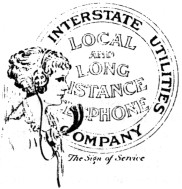Ma Bell's Place
by Vic Sumner
Reprinted from "Crown Jewels of the Wire", October 1985, page 6
With this month's issue we introduce a new column to be known as "Ma
Bell's Place," written by Vic Sumner, Historian and Curator for the De Anza
Chapter of the Telephone Pioneers of America in Southern California. Vic has
been a collector of insulators and telephone memorabilia since 1948. He and his
able assistant and wife, Lynn, are both retired from Pacific Telephone and
Telegraph Company. They developed the idea of retiring Ma Bell when divestiture
forced the end of the Bell System. Vic's stories are an attempt to relate the
human interest side of telephone history as seen through "her" eyes.

Dear Friends,
As you may have heard, in the early days of telephony much of our work was,
well, sort of experimental. This was true of all departments, because it was a
new industry and we had yet to write the book.
For example, when we first began to string wire, we just naturally copied the
methods of the telegraph companies, who preceded us by about 30 years. They had
found the easiest method to get a line from here to there was to string it
across the rooftops and, in most larger cities, that's what our boys did.
In San Francisco, as in all cities, we soon concluded the rooftops were
unsuitable for a number of reasons, not the least of which were the complaints
about linemen walking the roofs while wearing their climbers and the lambasting
our wiremen took after they inadvertently dropped a rusty old wire on some
washerwoman's drying laundry. In 1880 we began planning to put all the wires on
poles set along the edge of the streets.
The first pole line construction started in front of the office at 222
Sansome Street, home of the Pacific Bell Telephone Company. The work had
progressed satisfactorily as far as the corner pole at Bush and Sansome, in
front of the Murphy-Grant Company. A Swede by the name of Sorenson was delegated
to dig a hole at this point. The beginning of this job brought a protest from
the head of the firm, but Sorenson had his orders to dig, and proceeded
accordingly. Down about 18 inches, the iron bar disappeared through the hole and
fell into the basement, disturbing the peace and quiet of the Murphy-Grant
shipping department, as well as wrecking about 20 feet of shelving.
This didn't interfere with the setting of the pole. A three-legged jenny was
erected and the pole swung into place. However, as soon as the butt appeared in
the basement, the shipping department got busy and, taking hold of that end of
the pole, shook it and wrecked the jenny. This was immediately replaced, and the
pole again swung into the hole. This time it was dropped with a thud that
brought it to the floor of the basement. The shipping department was still on
the job. Each one had an ax, and the pole began to disappear about six feet at a
time, until the top followed the butt into the hole. Incidental to its
disappearance, the Murphy-Grant shipping department appeared on the street, axes
in hand, and the fun began.
About this time, our Superintendent appeared on the scene. The story is told
that as axes, crowbars and shovels began to fly, so did the Super. An eyewitness
told me that you could have played cards on his coattails as he ran down the
street. A compromise was later affected, and the lead completed to Market
Street.
We soon found that building telephone lines along the city sidewalks was not
without its drawbacks. True, it served to get the wires off rooftops but we were
not deluged with complaints of a new nature. People, particularly those imbibers
of "old barley" were prone to walk into the poles. Many were often
injured, for the poles were square in those days. Another frequently heard
report regarded the habits of birds that used our wires as a convenient spot to
unload yesterday's lunch. It was a good thing that hats were in fashion in those
days.
An interesting and unexpected complaint was heard from an orphanage in
Dayton, Ohio. It seems that at bed time, the youngest of the children were
lulled to sleep by the humming of the telephone wires attached to the orphanage
roof. The morning after the wires were removed, the head mistress charged into
the local telephone manager's office demanding the lines go back on the roof so
she could "get a little peace and quiet."
As the years progressed, so did the number of wires and soon the poles were
over loaded. I remember one pole line on the West side of New York City that had
thirty 10-pin crossarms rising to 90 feet. We began considering the use of
underground cables about this time.
No one could have guessed then that the move towards cable was to ultimately
spell the death knell of our Crown Jewels.
| 